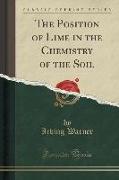- Start
- The Position of Lime in the Chemistry of the Soil (Classic Reprint)
The Position of Lime in the Chemistry of the Soil (Classic Reprint)
Angebote / Angebote:
Excerpt from The Position of Lime in the Chemistry of the Soil
But if we are to correctly advise our agricultural trade, then we must understand our subject thoroughly. It is broad and complex and must be studied diligently. Still it is founded on a few fundamental facts, which are exceedingly simple. It is these facts and the position of lime in reference to them with which we are here dealing.
It must first be understood that there are eight necessary ingredients to plant life. One authority, whom we will accept states. "Soils contain nitrogen, phosphorus, potassium, calcium, magnesium, sulphur, iron and chlorine, and if a soil is deficient in any of these essential elements of plant food, it will not produce a satisfactory crop." The first four are of major importance, the last four are minor. Of course, it is well known that other things are needed such as soil-air, moisture and humus or decaying organic matter, but we are dealing merely with the mineral chemistry of the soil and plant life. Also plants need carbon for their structure and this is obtained both from the atmosphere and from the humus of the soil, which in decaying evolves the gas, carbon dioxide or carbonic acid gas.
These elements do not appear in the soil or plant in their elementary form, but always as compounds. It is to be noted that of these substances named above, some are acid-forming and others are bases, i. e. form alkalis. The acid-forming are nitrogen, phosphorus, sulphur and chlorine, becoming respectively, nitric, phosphoric, sulphuric and hydrochloric acids. Carbon is also acid, forming carbonic acid. The bases are potassium, calcium and magnesium forming potassium, hydroxide, etc. The chemical and popular names of these acids and alkalis are shown on Table 1, together with their chemical composition. Iron is either acid or alkali according to conditions surrounding it.
Acids and alkalis combine together to form salts, which substances in general show neither acid nor caustic properties. A few familiar examples of such salts are calcium phosphate, commonly known as phosphate of lime, magnesium sulphate or Epsom salts, and potassium nitrate or nitrate of potash.
About the Publisher
Forgotten Books publishes hundreds of thousands of rare and classic books. Find more at www.forgottenbooks.com
This book is a reproduction of an important historical work. Forgotten Books uses state-of-the-art technology to digitally reconstruct the work, preserving the original format whilst repairing imperfections present in the aged copy. In rare cases, an imperfection in the original, such as a blemish or missing page, may be replicated in our edition. We do, however, repair the vast majority of imperfections successfully, any imperfections that remain are intentionally left to preserve the state of such historical works.
Folgt in ca. 15 Arbeitstagen




